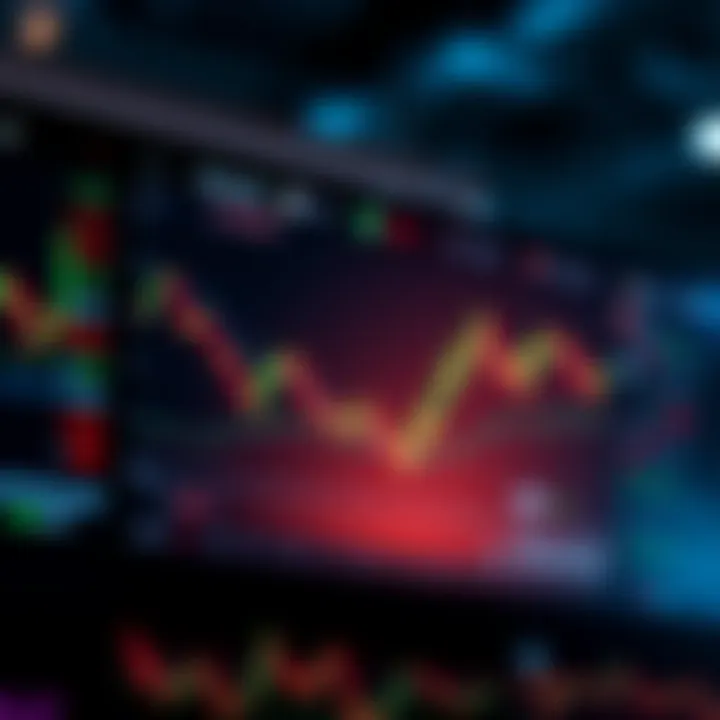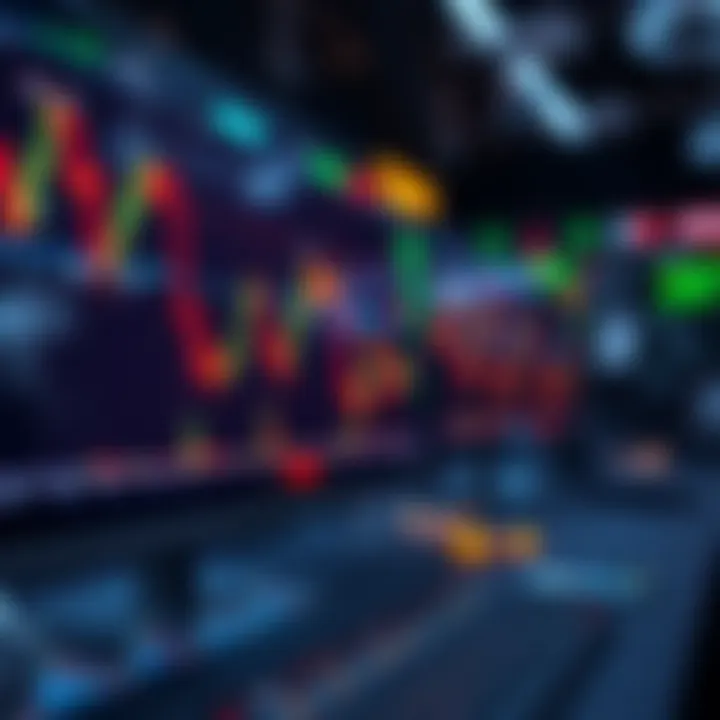Futures Trading on Webull: A Comprehensive Guide


Intro
In the world of finance, futures trading presents an intriguing avenue for both novice and seasoned investors. When contemplating where to execute such trades, many may turn their attention towards Webull, a platform that has garnered considerable popularity. With its user-friendly interface and zero-commission trading model, it offers an inviting space for those looking to navigate the sometimes tumultuous waters of futures trading.
But does Webull actually cater to futures trading? That question opens a multitude of discussions around the unique features of this platform, the implications for investors, and how it stacks up against competitors. This investigation won’t be a mere surface-level glance; rather, we’ll dive deeply into the mechanics of futures trading on Webull, explore its functionalities, and weigh its merits against alternative platforms.
Through a comprehensive exploration, we aim to furnish our readers with a robust understanding of the current state of futures trading on Webull. This will ultimately empower you, whether you’re an old hand at trading or just dipping your toes into the market, to make well-informed decisions tailored to your financial aspirations.
Prelude to Webull
Understanding the foundation of Webull is crucial for anyone interested in futures trading. This platform has carved out a niche for itself by combining advanced trading tools with user-friendly navigation, catering to both seasoned traders and newcomers alike. With the flexibility of mobile and desktop capabilities, Webull provides a robust environment for executing trades efficiently and accessing vital market data.
Overview of the Webull Trading Platform
Webull is often described as a modern trading platform that offers a sophisticated mix of features designed to appeal to today's investors. It allows users to trade not just stocks, but ETFs, options, and as of recent developments, futures as well. The platform stands out due to its commission-free trading model, a clear draw for those wary of high brokerage fees eating into their profits. Users can access real-time market data, in-depth charts, and comprehensive research tools, making informed decisions much easier. In an era where studies and data often dictate market movement, having such resources at one’s fingertips is invaluable.
The Webull platform provides educational resources, helping users navigate the complexities of trading, especially in more intricate areas like futures. This educational aspect cannot be overstated, as it equips investors with the knowledge necessary to understand market swings and the underlying mechanics of future contracts. Just think of it as having the right toolbox before starting on a DIY project; without the right tools, success can be hit or miss.
User Experience and Interface
When it comes to user experience, Webull takes the cake. The platform’s interface is sleek and modern, demonstrating an intuitive layout that can make even beginners feel at ease. Navigation through various sections feels seamless, ensuring that users can switch from checking stock prices to analyzing futures data without significant hassle.
On the mobile front, the Webull app stands out in the crowded field of trading applications. It's designed to provide a smooth and responsive experience even when you're on the go. Whether you’re at a coffee shop catching up on trades or at home gearing up for a busy trading session, Webull's mobile application doesn’t skimp on features, allowing for a comprehensive trading experience from anywhere.
Visual aesthetics play a big role as well—clean lines, thoughtful color schemes, and a respectable amount of white space contribute to a less overwhelming experience. Research also supports that a simple, clean design can enhance understanding and retention of information. For investing novices, the reduced cognitive load could translate into greater confidence during trades. So, while the bells and whistles in trading platforms can be appealing, Webull prioritizes functionality and user-centered design, making it a commendable choice for any investor.
Investing is about making informed decisions, and an efficient platform like Webull enhances investor capabilities through its features and design.
Understanding Futures Trading
Futures trading has gained significant traction in financial markets, and understanding its mechanics is crucial for investors utilizing platforms like Webull. Engaging in futures trading offers the potential for leveraging positions and diversifying portfolios. This section aims to break down the intricacies of futures trading, highlighting its benefits alongside the risks involved.
Definition and Mechanics of Futures Trading
At its core, futures trading involves agreements to buy or sell an asset at a predetermined price, set to be traded on a specific future date. Unlike stocks, which represent ownership in a company, futures contracts symbolize a commitment to transact in the future. These contracts cover various assets including commodities, currencies, and indices.
To better grasp the mechanics, consider this example: An investor anticipates an increase in crude oil prices. They might purchase a crude oil futures contract at $70 per barrel to lock in their price. If, as projected, the price rises to $75, the investor could sell their contract for a profit.
Key aspects of futures trading include:
- Speculation: Investors seek profit by predicting price movements.
- Hedging: Producers and consumers of commodities use futures to lock in prices, safeguarding against price fluctuations.
- Leverage: Futures contracts usually require a margin, enabling traders to control larger amounts of assets with a smaller initial investment.
Advantages and Risks of Futures Contracts
Futures contracts carry both potential benefits and inherent risks. Understanding these factors is essential for anyone looking to trade on platforms like Webull.
Advantages
- High Leverage: Traders can control a significant exposure to an asset while committing only a fraction of the total value upfront.
- Liquidity: Many futures markets are highly liquid, providing ease of entry and exit.
- Price Transparency: Futures prices are publicly available, offering a clear view of market sentiment.
Risks
- Volatility: The potential for rapid price shifts can lead to substantial gains or significant losses, particularly in highly leveraged positions.
- Margin Calls: If the market turns against a futures position, traders may receive a margin call, requiring them to deposit additional funds to maintain their position.
- Complexity: Navigating the nuances of futures trading can be challenging, particularly for those new to financial markets.
Understanding futures trading requires thorough research and preparation. This is not a market for the faint of heart, and it's beneficial for traders to deepen their knowledge and strategize based on current market conditions.
Does Webull Support Futures Trading?
Discussing whether Webull supports futures trading opens up a dialogue about its capabilities in this competitive financial landscape. Understanding Webull’s offerings is crucial for investors, especially as they navigate the often complex and rapidly shifting world of trading. Futures trading is a product that allows users to buy and sell contracts for various assets, which can include commodities, currencies, or indices. The efficiency of a trading platform can heavily influence the success or failure of a futures strategy.


Current Status of Futures Trading on Webull
As of now, Webull does not offer futures trading as part of its functionalities. This can be somewhat concerning for investors looking for a comprehensive trading experience on a single platform. While Webull excels in areas like stock trading and offers robust tools for analysis, its lack of futures trading might push some traders to seek alternatives. However, Webull does provide extensive educational resources which can be beneficial for those looking to understand futures basics while they wait for any potential updates.
Despite this limitation, a great draw for Webull is its commission-free trading structure, which allows users to engage in stock, option, and ETF trades without incurring fees. Investors might weigh this favorable aspect against the absence of futures as they explore their trading choices.
"The absence of futures trading on Webull could limit the strategies available to some traders, particularly those focusing on hedging, risk management, or diversification strategies that futures markets often provide."
Comparison with Other Trading Platforms
When examining Webull's offerings side-by-side with competitors like TD Ameritrade or Interactive Brokers, it becomes clear that the latter two platforms provide a well-established framework for futures trading. Here’s a brief look at how Webull stands in comparison:
- TD Ameritrade:
- Interactive Brokers:
- Webull:
- Offers a wide array of trading products, including futures, with detailed research tools and educational content.
- Charges commissions on futures trades but provides a comprehensive experience that justifies the fees for experienced traders.
- Renowned for low trading costs and a robust futures trading platform that caters to active traders and institutional clients.
- Offers a desktop trading app that includes advanced charts and customizable features, unmatched by Webull at present.
- Excels at commission-free stock and ETF trading but lacks futures trading.
- Contains useful mobile and desktop tools that cater well to standard equity traders but not to those focused on futures.
The choice between these platforms often depends on individual trading needs—whether one prioritizes comprehensive access to various traded assets, or if they are satisfied with Webull's offerings in stocks and options while waiting for future developments.
Understanding these differences can prepare investors for effective trading, ensuring they select platforms that align with their strategies and financial goals.
Features of Webull's Trading Platform
When looking into the world of futures trading on Webull, it is essential to consider the features that the platform offers. These elements not only shape the trading experience but also influence how investors manage their strategies. Understanding these features can make a significant difference in both short-term gains and long-term success in the trading arena.
Mobile and Desktop Application Functionality
Webull provides a seamless experience across its mobile and desktop applications. The design aims to offer traders the flexibility to track and execute trades on the go without compromising functionality. The apps are often praised for their user-friendly interfaces, enabling users to navigate through various tools quickly. For instance, the mobile version retains the essential features of the desktop application; this includes functions like live quotes, customizable watchlists, and advanced charting capabilities.
The mobile platform's capability allows traders to react to market changes in real-time, an essential factor for those dealing with futures where timing is everything. Notable functionalities include:
- Instant Notifications: Users can receive alerts for price changes, trade executions, and other relevant updates. This is significant for futures trading, where market prices can shift rapidly.
- Multitasking Features: The app allows for easy switching between different assets, making it simpler to manage various trades at once. This multitasking capability can be a game changer for day traders.
Tools for Technical Analysis
Technical analysis plays a pivotal role in the trading of futures contracts, and Webull comes equipped with several advanced tools in this area. The platform provides a selection of indicators that are essential for analyzing market trends, such as moving averages, Bollinger Bands, and RSI (Relative Strength Index). These tools allow investors to make informed decisions based on historical data.
Moreover, the charting features are customizable, enabling traders to tailor their views to suit their strategies. This can include:
- Interactive Charts: Users can zoom in on specific time frames and overlay various indicators.
- Drawing Tools: Features like trend lines and Fibonacci retracements help traders visualize market behavior effectively.
Having these tools at one’s disposal can significantly enhance one's ability to predict market movements and respond accordingly, thereby improving the likelihood of successful trades.
Community Insights and Social Features
In today’s trading world, information is currency, and Webull facilitates this through its social features. Investors can engage with each other to share insights, strategies, and analysis, creating a community-driven environment. This aspect is particularly beneficial for newcomers who can learn from seasoned traders.
Key elements include:
- Discussion Boards: Users can post questions, share analysis, or critique strategies, bolstering a collaborative learning experience.
- Social Sentiment Analysis: Webull provides insights into what other traders are thinking about particular assets, allowing users to gauge market sentiment. This can be a powerful tool for evaluating whether to enter or exit a position.
By leveraging these community insights, traders can potentially improve their trading strategies and make more informed decisions based on collective knowledge rather than just individual analysis.
"In the world of trading, knowledge shared is knowledge multiplied."
Alternative Platforms for Futures Trading


When considering futures trading, examining alternative platforms is crucial. With a plethora of options available, knowing how they stack up against Webull can provide a lay of the land for both newbies and seasoned traders. The diverse offerings of these platforms can not only enhance a trader's experience but also influence their overall strategy and success in the market.
The significance of exploring these alternatives lies in the distinct features they provide, which can cater to a wide array of trading styles and needs. Each platform often presents unique functionalities that can benefit individual investors. For instance, some may focus on advanced technical analysis tools, while others may offer robust educational resources. Understanding these nuances helps traders make informed decisions about where to execute their trades.
Several such platforms have carved their niches in the futures trading realm, and these include familiar names like TD Ameritrade, NinjaTrader, and E*TRADE. Choosing the right platform involves weighing various factors including pricing structures, user interfaces, and available analytics tools.
Comparison of Popular Futures Trading Platforms
Making an apples-to-apples comparison between major trading platforms is worth its weight in gold for prospective futures traders. Below are some key points of differentiation:
- TD Ameritrade: Renowned for its comprehensive educational resources, TD Ameritrade offers thinkorswim, an advanced trading platform known for its rich analytical capabilities. Cost-wise, they may charge commissions for some futures trades, but the depth of their resources often justifies these expenses for many.
- NinjaTrader: This platform is designed with active traders in mind. It stands out due to its powerful charting and market analysis tools that are ideal for day trading futures. However, it does have a steep learning curve, which could be a barrier for beginners.
- E*TRADE: With a user-friendly interface and competitive commission rates, E*TRADE is a solid choice for both newbies and experienced traders. Its platform provides a good balance of tools and educational material, making it easy to navigate the world of futures trading.
A trader's choice may pivot on what they value the most—advanced tools, educational support, or perhaps just plain simplicity. Each platform has its pros and cons, creating a diverse landscape for futures trading.
Key Features to Look for in a Futures Trading Platform
When evaluating futures trading platforms, certain core features must not be overlooked. These elements can significantly impact trading success:
- User Interface: A clean and intuitive interface helps in executing trades swiftly and accurately, which is essential in the fast-paced futures market.
- Commission Fees: Low-cost trading options can save traders money, especially those who execute numerous trades within a short timeframe.
- Market Data: Access to timely and comprehensive market data gives traders the necessary edge when making informed decisions. Real-time data is vital for assessing market movements.
- Analytics Tools: Robust analytical tools allow traders to visually interpret market trends and make decisions based on informed data analysis. Look for features such as customizable charts and technical indicators.
- Education and Resources: Platforms that offer extensive educational materials can help traders improve their skills and learn new strategies.
- Customer Support: Reliable customer service ensures that any issues can be addressed swiftly, preventing any potential losses.
Investors should weigh these factors in the context of their individual trading strategies and goals. Recognizing what matters most can assist in selecting a platform that not only meets but exceeds their futures trading needs.
Navigating the Futures Market
Understanding how to effectively navigate the futures market is crucial for anyone looking to trade on Webull or similar platforms. Futures trading can often feel like stepping into a labyrinth, laden with complexities that can leave even seasoned traders feeling a tad lost. By concentrating on the right strategies and keeping abreast of market dynamics, traders can not only survive but thrive in this high-stakes environment.
Market Trends and Analysis
The pulse of the futures market is dictated by trends that emerge from a myriad of factors, including economic indicators, global events, and technological advancements. For traders, recognizing these trends is like having a map in that previously mentioned labyrinth. It points out potential opportunities and hidden paths that can lead to profitable outcomes.
Utilizing tools like moving averages, historical price patterns, and volume analysis can provide traders with a clearer picture of market direction. For example, let’s say you’re tracking crude oil futures. Noticing a spike in prices in response to geopolitical tensions could signal a bullish trend. It’s essential to keep in mind that these trends are not set in stone; they can shift rapidly, influenced by new data releases or unexpected events.
Several key elements are worth monitoring:
- Economic Indicators: Metrics such as employment rates, inflation data, and GDP growth can significantly influence market sentiment.
- Geopolitical Events: Supply disruptions from conflicts or natural disasters can alter forecasts and pricing strategies.
- Technological Changes: Innovations in trading algorithms or analytics tools can shift trading dynamics faster than one might anticipate.
The better equipped you are to analyze these trends, the more deftly you can navigate the market.
Developments Impacting Futures Trading
In futures trading, being aware of the recent developments can greatly enhance or hinder trading decisions. The landscape evolves rapidly, and staying informed about changes in regulations, market participation, or technological innovations is paramount.
For instance, the introduction of new regulatory frameworks can reshape the way futures contracts are traded. Understanding these rules can help traders avoid pitfalls while ensuring they remain compliant. In recent years, platforms like Webull have improved accessibility to futures trading, allowing more individuals to enter the space without the traditionally high barriers to entry. With this influx of retail traders, liquidity in the market has increased, but so has volatility — another aspect to consider seriously.
Moreover, developments in automated trading systems and artificial intelligence have transformed methodologies in futures trading. More trades executed in fractions of a second can mean price movements occur at an unprecedented pace. Traders need to stay agile and adapt to these technological advancements to remain competitive.
To sum it up, being informed on market trends and developments isn’t just beneficial; it’s critical. Knowledge is power in futures trading, and those who keep their ear to the ground will reap the rewards.
Strategies for Successful Futures Trading
Understanding the landscape of futures trading is like navigating a winding road; it requires strategic foresight and the adaptability to utilize diverse tools efficiently. In the world of futures, where stakes can be high and time is of the essence, adopting a well-crafted trading strategy is not just beneficial—it's paramount. The following sections will dive into the two most prominent strategies used by traders: Fundamental Analysis and Technical Analysis. Both approaches provide unique insights that can help traders make informed decisions, enhancing their likelihood of success in a competitive market landscape.
Fundamental Analysis in Futures Trading
Fundamental analysis revolves around assessing the intrinsic value of futures, influenced by various economic factors. This method looks at key indicators like supply and demand, production levels, etc., and how they affect prices.
Here are some core elements that traders consider:
- Supply and Demand: Understanding the balance between production rates and consumption can indicate potential price shifts. For example, if a crop yield is expected to be low due to adverse weather conditions, the price of related futures contracts might rise.
- Economic Indicators: Macroeconomic data such as GDP growth rates, employment figures, or inflation rates can dramatically influence market sentiment and trader behavior.
- Geopolitical Events: Political unrest, trade agreements, or changes in monetary policy can impact futures markets. It's crucial for traders to stay abreast of global news that could sway prices.


Utilizing fundamental analysis helps traders grasp not just what is happening, but why it's happening in the market. In many ways, it’s like putting together a puzzle. Understanding the big picture can lead to more informed positions that align with anticipated market movements.
Technical Analysis: Tools and Techniques
Technical analysis, in contrast, is a more mathematical approach. It focuses on historical price movements and market trends to predict future performance. Here are some essential tools and techniques employed by traders:
- Charts: Line charts, bar charts, and candlestick charts help visualize price movements over time. Each type offers unique insights about market behavior, like how high or low prices have fluctuated within a given period.
- Indicators: Tools like Moving Averages and Relative Strength Index (RSI) help traders identify patterns. For instance, a trader may use the RSI to determine if an asset is overbought or oversold, offering a clue about potential price corrections.
- Volume Analysis: Observing trading volume can reveal market strength or weakness behind price movements. High volume typically signifies strong interest from traders, while low volume might suggest a lack of conviction in price movement.
Incorporating technical analysis allows traders to react more swiftly to price changes. It’s akin to having a roadmap that outlines previous routes taken; it helps in navigating future market possibilities with a semblance of confidence.
"A successful trader synthesizes both fundamental and technical analysis. Each offers valuable insights that, when combined, create a holistic view of market dynamics."
Strength in futures trading comes from a fusion of well-researched methods and the flexibility to adapt. Utilizing both fundamental and technical analysis, traders can build a robust strategy that resonates with their individual trading style while equipping themselves with the tools necessary to thrive in the fast-paced world of futures.
The Future of Futures Trading
As we delve deeper into the realm of futures trading, understanding its future importance is essential. The evolving financial landscape necessitates a reassessment of how investors engage with these markets. With Webull emerging as a competitive trading platform, it’s crucial to consider the elements, benefits, and potential shifts that may characterize the future of futures trading.
Futures trading is not just a technique for hedging or speculation; it’s rapidly becoming a cornerstone of modern investment strategies. The increasing accessibility of trading platforms like Webull democratizes participation for everyday investors, significantly altering market dynamics. As more individuals gain access to sophisticated trading tools, the participation from retail investors could add significant liquidity to the market.
Benefits of Understanding Future Trends in Futures Trading:
- Informed Decision-Making: Grasping emerging trends allows traders to anticipate market changes.
- Competitive Edge: Knowledge of new strategies and tools can enhance trading outcomes.
- Risk Management: Being aware of market evolutions can better position investors against unforeseen market shifts.
Furthermore, futures traders are increasingly leveraging technology for their trading endeavors. Advanced algorithms and artificial intelligence are reshaping how trades are executed. Real-time data analysis is making it easier for investors to react to market fluctuations, potentially increasing their profitability. Tools offered by platforms like Webull, such as price alerts and technical indicators, enable traders to refine their strategies based on instant feedback and insights.
"The future belongs to those who prepare for it today." – Malcolm X
This quote resonates strongly in the context of futures trading as traders arm themselves with knowledge and strategic foresight. Considering these factors highlights the importance of staying ahead of the curve in such a volatile market.
Emerging Trends in Futures Trading
As we look forward, several trends are crystallizing that could shape the futures trading landscape. Firstly, the rise of decentralized finance (DeFi) could play a pivotal role. With blockchain technology hitting its stride, clearing processes are becoming more efficient, which in turn reduces transaction times and costs.
Additionally, algorithmic trading is firmly establishing itself. Automated trading systems can analyze vast amounts of data, making decisions in seconds—much faster than a human trader ever could. Their increasing accuracy may lead to more sophisticated trading strategies that could potentially mitigate risks and enhance returns.
Another important trend is the broader acceptance of environmental, social, and governance (ESG) criteria in trading decisions. More investors are weighing these factors heavily while considering their future in the markets. This trend reflects a growing awareness of sustainability, influencing investor behavior toward futures based on renewable energies, carbon credits, and similarly oriented assets.
Predictions for Market Evolution
Looking ahead, the predictions for market evolution in futures trading are both intriguing and varied. Analysts expect that as technology continues to evolve, more retail amateur traders will enter the space, increasing competition and liquidity. Future platforms, including Webull, will likely adapt their offerings to include new asset classes and trading strategies catering to this expanding demographic.
Moreover, regulatory changes may emerge in response to the evolving landscape. As futures trading becomes more popular among everyday investors, regulators may tighten guidelines to safeguard investors, creating a more balanced playing field.
In summary, the future of futures trading is shaped by the intersection of technology, regulatory changes, and evolving market participants. Staying aware of these emergeing trends can help investors strategize more effectively, ensuring they remain competitive in an increasingly complex financial landscape.
Ending
The conclusion section serves as a crucial component of our deep-dive into the complexities of futures trading on Webull. It brings together the threads woven throughout the article, highlighting the essential points that every reader should take away after engaging with the material. In this rapidly evolving arena of digital finance, understanding the nuances of futures trading is not just beneficial; it's essential for anyone looking to navigate today’s market effectively.
Summarizing Key Insights
As we reflect on the elements discussed, several key insights emerge:
- User-Friendly Interface: Webull’s trading platform is designed with a strong emphasis on user experience. This is critical for both novice and experienced investors who want to streamline their trading processes.
- High-Leverage Opportunities: Futures contracts carry the allure of leverage, allowing traders to maximize their potential profits. However, this also introduces higher risks that must be understood thoroughly.
- Educational Resources: Webull provides educational tools and community features that empower traders to make informed decisions. This is particularly significant for those entering the futures market for the first time.
- Market Trends: A keen awareness of market trends and developments is vital. Active traders need to stay updated on factors influencing price movements to position themselves advantageously.
- Comparison with Other Platforms: Throughout the article, we have compared Webull with other trading platforms. Understanding these differences can help users make the best choice for their individual trading strategies.
Final Thoughts on Webull and Futures Trading
Webull’s strengths, paired with a comprehensive understanding of futures mechanics, enables traders not only to participate but to thrive in a competitive landscape. As the landscape of futures trading continues to evolve, staying informed and adaptable will serve as the linchpin to securing one’s financial future. Ultimately, it is not just about the means of trading, but the strategies and insights that will carve out your path in this dynamic financial landscape.
"To be prepared is half the victory." - Miguel de Cervantes
Further Resources: For more detailed insights on futures trading, visit Investopedia, and for community discussions, check out Reddit.
Educators, analysts, and savvy marketers should be actively engaging with these insights while fostering discussions that encourage a more profound understanding of trading strategies and market dynamics.







